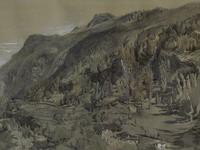John Ruskin and the Geographical Imagination
Denis Cosgrove selects works from Ruskin’s Teaching Collection and reveals a poetry of landscape that inspired geographical learning a century ago.

Ruskin took a special interest in the skies: the primary source of light in any landscape art and the physical canvas upon which divinity is sketched. Cloud studies represented both the most important and the most difficult of subjects for the student of drawing because of the transience of cloud forms. Ruskin recommended daily quarter-hour contemplation of the dawn clouds as part of morning devotions, keeping pencil and brush to hand to record particularly beautiful occasions. (21:106-107) From its origins, geographical education at the School of Geography required students to undertake a period of daily weather observation and recording.
'… little more than memoranda of the sky as they passed … outlined with pencil from the clouds themselves, at the utmost speed. The colour necessary to explain their mode of illumination is to be added from direct memory, before you look at anything else. … stop in working on them the instant your memory fails, so that you may be able to certify their veracity as far as they reach.' (21:106)
Symbolic of 'the rising of the light of heaven above the horizon of our life.'
Ruskin’s rendering of the cloud forms from Turner’s 'Campo Santo, Venice' which Ruskin owned. 'There’s a bit of blue sky and cloud by Turner - one of the loveliest ever painted by human hand. But, as a mere pattern of blue and white, he had better have painted a jay’s wing: this was only painted - and is, in reality, only pleasant to you - because it signifies the coming of a gleam of sweet sunshine in windy weather; and the wind is worth thinking of only because it fills the sails of ships, and the sun because it warms the sailors.' (22:15)
'Campo Santo, Venice' by JMW Turner, 1842, is now in the Toledo Museum of Art, Ohio.
References
All references to Ruskin's writings are taken from The Works of Ruskin, Library Edition, 39 volumes, edited by E.T. Cook and Alexander Wedderburn, George Allen, London, 1903-1912 and given by volume number and page.







